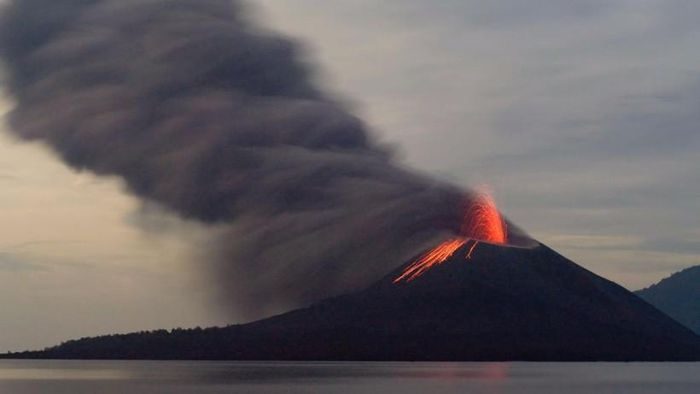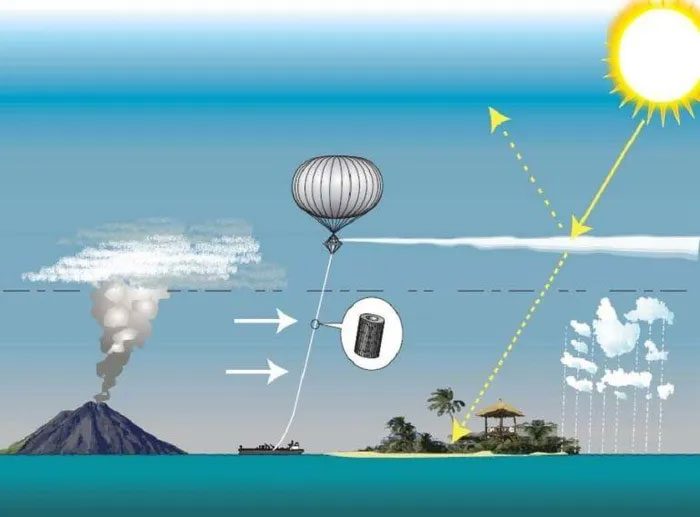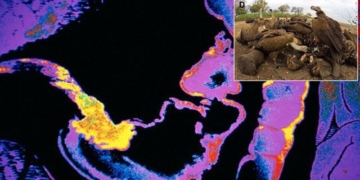Volcanic eruptions can lower the Earth’s surface temperature.
From this natural phenomenon, scientists are exploring the possibility of releasing gases into the atmosphere to combat climate change.
Feasibility of the Idea
Considered the largest explosion in human history, the eruption of Mount Tambora in Sumbawa, Indonesia (April 17, 1815), released around 150 cubic kilometers of rocks and ash into the atmosphere, causing global temperatures to drop by as much as 3 degrees Celsius. During the eruption, the surrounding area was described as “the year without a summer.”

Gases released from volcanic eruptions lower the Earth’s surface temperature.
This phenomenon occurs because when a volcano erupts, gases such as SO2, dust, ash, and water vapor are released into the atmosphere. Among these, aerosols reflect radiation back into the atmosphere, particularly radiation from the sun, which lowers the Earth’s surface temperature.
Climate scientists assert that the world must keep global temperatures from rising more than 1.5 degrees Celsius to mitigate the worst impacts of climate change. However, achieving this target is becoming increasingly difficult.
In October 2022, Simon Stiell, Executive Secretary of the United Nations Framework Convention on Climate Change, warned that countries’ carbon reduction efforts were still “nowhere near the scale and speed of emissions reduction needed” to meet the 1.5-degree goal.
In light of the urgent situation and volcanic eruptions, scientists worldwide are asking whether it is possible to mimic the cooling effects of volcanic eruptions to prevent global warming. This idea is known as stratospheric aerosol injection.
This is one of the new technologies in the field of Solar Radiation Management (SRM) and is expected to be a potential solution to mitigate the impacts of climate change.
In reality, most SRM solutions have yet to be tested in the real world. Previously, in 2019, Harvard University planned to inject aerosols into the atmosphere to combat climate change. Essentially, these would create a shield made from millions of tons of sulfate particles that reflect sunlight, preventing the Earth from overheating as it currently is.
This approach is also not expensive. By using a fleet of aircraft to spray sulfate particles into the lower stratosphere, Harvard’s research indicated that the costs for this ambitious project could be within the reach of many countries. Harvard estimates that the initial project would cost about $3.5 billion, with an annual maintenance cost of $2.25 billion.
In Asia, in recent years, SRM technology in general and stratospheric aerosol injection have been actively researched. Recently, in Thailand and Indonesia, two scientists, Pornampai Narenpitak and Heri Kuswanto, have independently studied the feasibility of this approach.

Illustration of the aerosol injection process into the atmosphere.
Challenges in Realization
Some climate activists have raised concerns about ethical risks, arguing that this technology could weaken countries’ commitments to reduce global greenhouse gas emissions and enable companies to continue polluting. Additionally, there are geopolitical worries as developed countries struggle with the energy transition.
However, whether SRM should be considered a solution to climate change remains a contentious issue. For now, in the United Nations Environment Programme’s 2022 Emissions Gap Report, this technology is not viewed as a strategy for mitigating climate change.
The main reason is that this technology carries numerous consequences. It is important to note that since 2019 and likely in the near future, no country has conducted experiments with this model, despite ongoing research. This is because aerosols can adversely affect human health and potentially “poison” an already fragile atmosphere.
Notably, recent studies by scientists in Sumatra and Kalimantan found that injecting aerosols into one area could lead to temperature increases in other regions. Since SRM involves shooting chemicals into the atmosphere at altitudes of 20-30 km above the Earth’s surface, the implementation of this technology by one country could affect weather patterns in other parts of the world.
Similarly, Professor Govindasamy Bala, working at the Indian Institute of Science’s Centre for Atmospheric and Oceanic Sciences, discovered in computer model experiments that the effects of aerosol injection could vary depending on the latitude of the implementation site.
For instance, one climate model predicted different impacts of aerosol injection on wind-driven rainfall across the hemispheres. Aerosols injected at a latitude of 15 degrees North could reduce rainfall in the Northern Hemisphere while increasing precipitation in the Southern Hemisphere, or vice versa.
“Injecting aerosols into the atmosphere has the potential to reduce global warming. We know that this approach will be effective, but the impact is uneven and could have side effects. Moreover, if we have the ability to control the climate, the more difficult question is who will decide?” stated Professor Govindasamy Bala.
Maintaining a neutral stance on aerosol injection, the two scientists from Thailand and Indonesia agreed that researching this technology will help understand how SRM works and provide a contingency plan for worst-case scenarios.
However, both emphasized that aerosol injection specifically, and SRM technologies in general, should not be seen as a complete substitute for carbon emission reductions. They should be considered as supplementary technologies in the fight against climate change.


















































